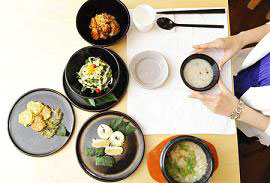PYEONGTAEK, South Korea — A centuries-old tradition of Buddhist cuisine, with strict bars on foods linked to lust or anger, is enjoying a revival in South Korea, one of Asia’s most high-stress societies.
 “Temple food,” as it is generally known, is moving out of the temples and monasteries and into mainstream restaurant culture, attracting a loyal following for its deceptive simplicity and health-giving properties.
“Temple food,” as it is generally known, is moving out of the temples and monasteries and into mainstream restaurant culture, attracting a loyal following for its deceptive simplicity and health-giving properties.
Among its most skillful practitioners – and ardent promoters – is a 54-year-old monk, Jeokmun, who has devoted several decades to refining what he sees as a meditative diet that feeds both soul and body.
At his modest Sudoksa temple in Pyeongtaek City, about 60 kilometres south of Seoul, Jeokmun teaches his techniques to an attentive class of a dozen students – mostly middle-aged housewives.
Shaven-headed with a round, tanned face, the monk shows off his knife skills as he dexterously chops cucumbers and bell peppers and cuts delicate slices of soft tofu.
His recipes for the day include tofu sauteed in plum-sauce, mushroom casserole, radish kimchi and noodles mixed in chilli sauce and vegetables.
“Temple cuisine means low-calorie dishes that make your body healthy and your spirit clean,” Jeokmun said, as he makes fine diagonal slashes across the tofu slices to allow the plum-and-soy sauce flavour to penetrate.
Apart from a few dairy ingredients, temple food is largely vegan in nature and incorporates an impressive variety of wild roots, herbs and vegetables.
Its new-found popularity is partly attributable to the search for a healthier diet in a country which, like other Asian nations that experienced rapid economic development, has growing levels of obesity and diabetes.
As well as eschewing artificial flavourings and additives, temple cuisine also bans such vegetarian staples as chives, leeks, scallions, garlic and onion — known in the Buddhist traditions the “five pungent vegetables”.
“The wisdom is as follows,” Jeokmun explained. “Eaten cooked, these vegetable may incite the libido, while eaten raw they can set the mind to anger and greed.”
South Korea is the world’s third largest producer of garlic and a passionate consumer of the same.
For many Koreans, the absence of garlic from “kimchi” – the iconic national dish most commonly made of fermented cabbage – is unthinkable.
But Jeokmun sees no room for compromise.
Years ago, as a student reporter at a Buddhist college, he had been shocked to see scallion, garlic and even artificial flavour enhancers being widely used in the kitchens of many temples he visited.
Determined to bring the cuisine back to its roots, he set out on a nomadic life, visiting temples with renowned Buddhist chefs and learning their recipes.
In 1992, he launched a Korean temple food institute with like-minded monks and nuns.
In an effort to spread the message, he has taken part in numerous TV cooking programmes, given lectures and written several books, including one with 227 recipes that was published in 2000 and is now in its sixth re-print.
Jeokmun believes his food has wider appeal, including for foreigners who can have difficulties with standard Korean cuisine — known for its liberal use of salt and spice.
For one of his students, Chang Bong-Suk, 43, the monk’s teachings provide a path to bring a healthier diet to her family.
“I’ve been applying what I’ve learned here to cooking healthy meals at home, especially for my son who used to suffer from allergic skin problems,” Chang said.
Her son’s condition has improved as a result, she said, while admitting that her husband was less enamoured of the meatless diet.
“I transform the recipe a bit to make it more palatable for him,” she confessed.
“For example, when I make a steamed pumpkin, I put some shrimp inside the hollowed-out pumpkin, together with mushrooms, tofu, ginko seeds and pine seeds demanded in the original recipe,” she said.
While South Korean TVs, fridges and mobile phones have been exported with enormous success around the globe, Korea’s highly distinctive cuisine remains relatively unknown.
In recent years, the government has invited overseas chefs to special “gourmet weeks,” as it seeks to give Korean food the same exposure as Asian cuisines like Chinese, Thai and Japanese.
Some specialist dishes such as the pungent seafood delicacy “hongeo” – skate fermented in its own uric acid – will always be a hard sell, but staples like Korean barbecued beef and pork are already making inroads in the restaurant scene in western countries.
– Source : www.buddhistchannel.tv




